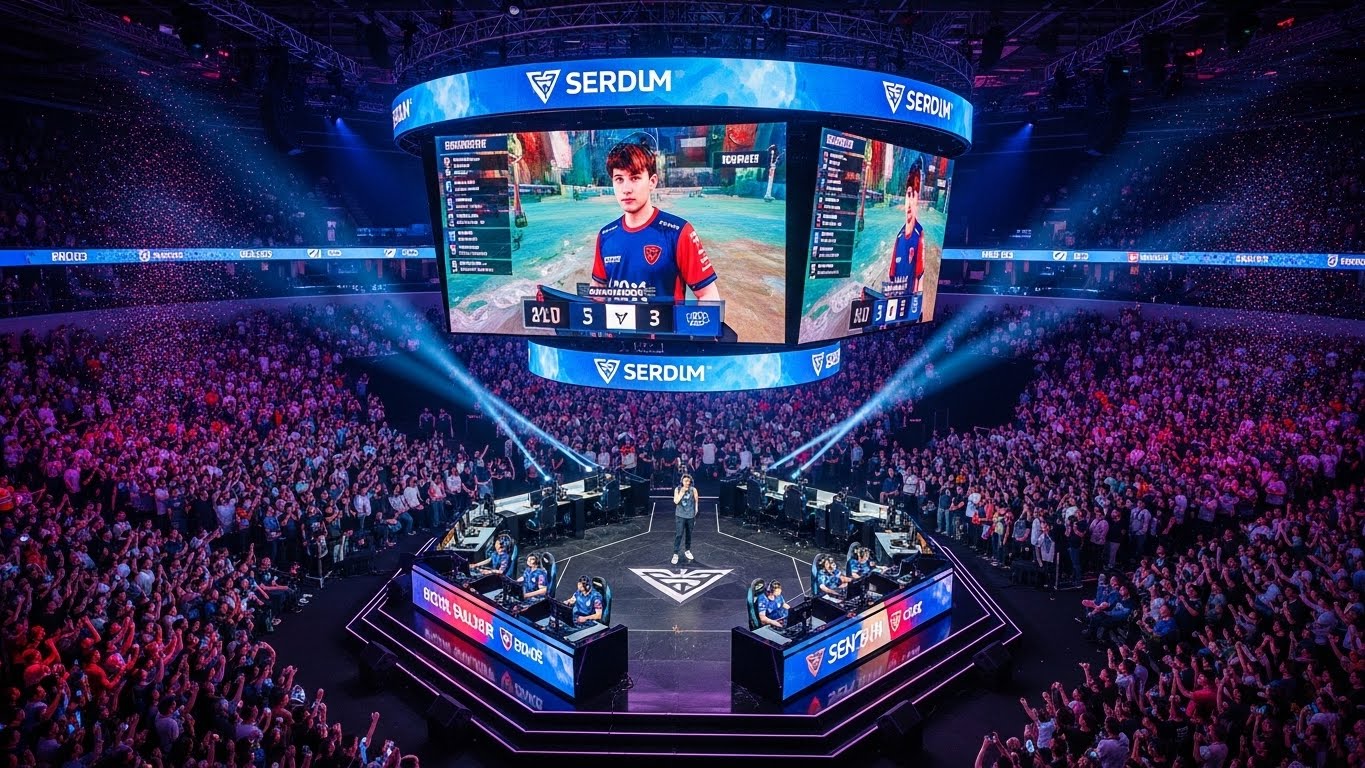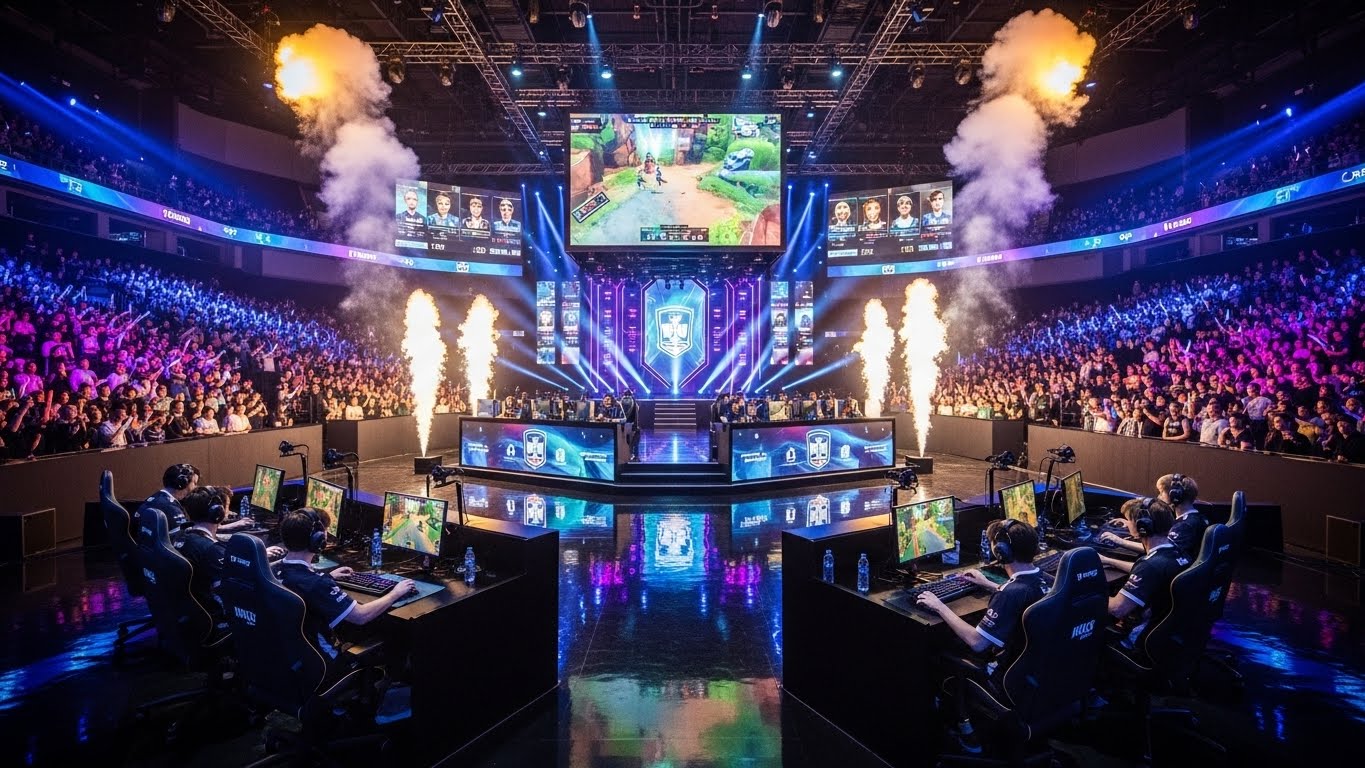Introduction: The Digital Revolution of Competition
A few decades ago, the idea of professional video gaming was hard to imagine. Video games were seen as a pastime — something kids did after school or adults enjoyed casually. Fast forward to today, and Esports has transformed into a multi-billion-dollar global industry, rivaling traditional sports in viewership, sponsorship, and cultural influence.
Esports — short for “electronic sports” — represents organized, competitive video gaming, often watched by millions both online and in packed stadiums. What was once niche entertainment has evolved into one of the most dynamic and fast-growing sectors in the entertainment industry. The rise of Esports tells a fascinating story of innovation, technology, community, and the redefinition of what it means to be an athlete.
The Humble Beginnings: The 1970s and 1980s
The roots of Esports trace back to the early days of gaming in the 1970s. The very first organized video game competition is often credited to a 1972 event at Stanford University, where students competed in Spacewar!, one of the earliest computer games. The prize was a one-year subscription to Rolling Stone magazine — modest by today’s standards but groundbreaking at the time.
During the 1980s, arcades became the social centers of gaming culture. Titles like Pac-Man, Donkey Kong, and Space Invaders inspired informal competitions among friends and local players. The Space Invaders Championship in 1980, organized by Atari, drew over 10,000 participants across the United States — a remarkable milestone that hinted at the potential of gaming as a spectator sport.
This era also saw the rise of gaming high-score culture. Players were featured in magazines like Twin Galaxies and Nintendo Power, celebrating those who could set world records. Though the competitions were small and localized, they laid the groundwork for something much bigger.
The 1990s: The Birth of Modern Competitive Gaming
The 1990s marked a major turning point. The rise of personal computers, better internet connectivity, and the popularity of consoles like the Super Nintendo and Sega Genesis pushed gaming into mainstream culture.
During this period, competitive gaming began to take a more structured form. Fighting games like Street Fighter II and Mortal Kombat became fixtures in arcades and tournaments, attracting dedicated players and passionate audiences. The first Evolution Championship Series (EVO), which began as a small fighting game event, would eventually grow into one of the biggest Esports tournaments in the world.
Meanwhile, the birth of PC gaming gave rise to new genres and new communities. Doom, Quake, and StarCraft introduced online multiplayer competition to a global audience. Quake in particular became the center of early professional gaming, with the first known Esports superstar — Dennis “Thresh” Fong — winning a Ferrari in a 1997 tournament.
These games showcased not just reflexes but strategy, teamwork, and coordination — the same traits valued in traditional sports. As internet cafes and local area network (LAN) parties grew in popularity, Esports began to attract attention beyond just hardcore gamers.
The 2000s: Globalization and the Rise of Major Leagues
The 2000s brought a new wave of transformation. With broadband internet becoming widespread and online gaming services like Xbox Live and Battle.net gaining traction, competitive gaming exploded.
In South Korea, StarCraft: Brood War became a cultural phenomenon. Dedicated Esports channels like OnGameNet broadcast tournaments to millions of viewers, and professional players gained celebrity status. South Korea effectively pioneered the model for organized, professional Esports — complete with teams, sponsors, coaches, and salaries.
The West wasn’t far behind. The Cyberathlete Professional League (CPL) and Major League Gaming (MLG) were founded, hosting large-scale events for games like Counter-Strike, Halo, and Call of Duty. These tournaments attracted corporate sponsors and began offering significant prize pools, bringing legitimacy to the concept of gaming as a career.
During this decade, streaming platforms and social media were still in their infancy. Most Esports fans watched highlights or recordings rather than live events. Yet, this period built the infrastructure and community foundations that would soon take Esports to unimaginable heights.
The Streaming Revolution: Twitch and YouTube Change Everything
If the 2000s built the foundation, the 2010s blew the roof off. The emergence of platforms like Twitch (launched in 2011) and YouTube Gaming transformed how people consumed gaming content. Suddenly, fans could watch their favorite players and tournaments live, interact in real-time, and even broadcast their own gameplay to global audiences.
This democratization of broadcasting was revolutionary. Esports no longer needed traditional TV networks — it had its own ecosystem. Streaming allowed players to build personal brands, and fans to feel more connected to their favorite teams and games.
During this time, games like League of Legends, Dota 2, and Counter-Strike: Global Offensive became household names in competitive gaming. Riot Games’ League of Legends World Championship filled entire stadiums and drew tens of millions of online viewers. Dota 2’s The International became known for its record-breaking prize pools, crowdfunded by fans through in-game purchases.
Esports had officially gone mainstream — and it wasn’t slowing down.
Esports Becomes Big Business
As viewership grew, so did investment. Esports began to attract major sponsors, investors, and traditional sports franchises. Companies like Coca-Cola, Intel, Red Bull, and Nike entered the scene, seeing Esports as a way to reach younger, tech-savvy audiences.
Franchise-style leagues emerged, mirroring traditional sports. The Overwatch League, for instance, introduced city-based teams, official seasons, and player contracts — elements that made Esports more structured and marketable.
Meanwhile, universities started offering Esports scholarships, and entire arenas were being built specifically for gaming events. Media giants began securing broadcast rights, and even the International Olympic Committee started exploring Esports as a potential competitive category.
By the late 2010s, the Esports ecosystem included professional teams, managers, analysts, psychologists, and dedicated training facilities. What had once been dismissed as “kids playing video games” had evolved into a professional industry with real infrastructure and global economic impact.
The Players: The New Generation of Athletes
One of the most fascinating aspects of Esports is how it redefines what it means to be an athlete. Esports players, or “pros,” often dedicate as much time to practice and training as athletes in traditional sports. They study gameplay footage, refine strategies, and maintain strict schedules.
Reaction time, hand-eye coordination, and mental endurance are critical. Top-level players may train eight to twelve hours a day, honing their reflexes and communication with teammates. Like traditional athletes, many also deal with burnout, injuries (like wrist or back strain), and the pressure of performing in front of millions.
The rise of youth academies and coaching systems has created clear pathways for aspiring players. Much like soccer or basketball, young talent can now be scouted, trained, and developed into professionals.
But beyond raw skill, Esports athletes also represent the blending of competition and entertainment. Many pros maintain personal brands, stream regularly, and interact with fans — balancing both competitive and influencer roles.
The Culture: More Than Just Games
Esports isn’t just about the competition; it’s about culture. It has built communities that cross borders, languages, and backgrounds. Fans don’t just watch tournaments — they create memes, fan art, commentary videos, and highlight reels. Esports has given rise to an entire ecosystem of content creators, casters, analysts, and journalists.
Events like DreamHack, EVO, and BlizzCon have become cultural festivals, where fans gather to celebrate gaming in all its forms. Cosplay, merchandise, music performances, and interactive fan zones have turned Esports events into immersive experiences.
The inclusivity of online platforms has also made Esports accessible to people worldwide. Anyone with an internet connection can participate, spectate, or even compete. This global accessibility has been one of the driving forces behind Esports’ meteoric rise.
The Economics of Esports
Behind the lights and excitement, Esports is a serious business. According to industry estimates, global Esports revenues have surpassed a billion dollars, driven by sponsorships, advertising, media rights, and merchandise sales.
The biggest tournaments now feature prize pools that rival traditional sports championships. For instance, The International has awarded tens of millions of dollars to winners, while Fortnite’s World Cup offered a $30 million prize pool in its debut year.
Teams have diversified revenue streams — from merchandise and content creation to partnerships and brand collaborations. Some organizations, like Team Liquid, Cloud9, and FaZe Clan, have evolved into multimedia powerhouses, representing gaming, fashion, and lifestyle.
Despite the success, challenges remain. Profitability can be elusive, and many organizations rely heavily on sponsorships. Maintaining audience engagement, player well-being, and sustainable tournament models are ongoing topics of discussion in the industry.
Esports and Education
In recent years, Esports has made surprising inroads into education. High schools and universities around the world are forming official Esports teams, offering scholarships, and integrating gaming into academic programs.
These programs emphasize teamwork, communication, and critical thinking — skills that extend beyond the game itself. Some institutions also use Esports as a gateway into broader studies like computer science, marketing, and event management.
The educational potential of Esports lies in its ability to connect passion with purpose. For students who might not be drawn to traditional extracurricular activities, Esports provides a way to build discipline, confidence, and leadership skills.
The Global Stage: Esports as a Cultural Bridge
Esports is one of the few activities that truly transcends geography. Players from North America compete against those from Europe, Asia, and South America in real time. Language barriers often fade as teams communicate through the universal language of gaming.
This global reach has turned Esports into a cultural bridge. Major tournaments attract international audiences, fostering cross-cultural exchanges and global friendships. Fans from different countries unite to cheer for their favorite teams and players, blurring the lines between nationality and fandom.
Esports During the Pandemic
When the COVID-19 pandemic halted traditional sports events, Esports thrived. With live stadiums closed, millions turned to online competitions for entertainment. Games like Valorant, Call of Duty: Warzone, and Among Us surged in popularity, and even traditional sports leagues like Formula 1 and the NBA organized virtual tournaments featuring real athletes.
This period proved that Esports wasn’t just an alternative form of competition — it was a resilient and adaptable industry capable of thriving under extreme circumstances. The pandemic accelerated digital adoption, and Esports became a lifeline for community connection during global isolation.
The Future: What’s Next for Esports?
Looking ahead, Esports shows no signs of slowing down. With advancements in technology, virtual reality, and artificial intelligence, the future of competitive gaming is filled with possibilities.
The integration of virtual reality could create new immersive formats where players and viewers experience the action more directly. The use of AI and data analytics will continue to refine coaching, performance tracking, and fan engagement.
There’s also growing interest in mobile Esports, particularly in regions like Southeast Asia and India, where mobile gaming dominates. Titles like PUBG Mobile and Mobile Legends have demonstrated that the Esports model can thrive beyond PCs and consoles.
As the industry matures, issues like player welfare, diversity, and sustainability will become increasingly important. The next phase of Esports will likely focus on creating a more inclusive and balanced ecosystem that benefits players, fans, and organizations alike.
The Debate: Is Esports Really a Sport?
The question of whether Esports qualifies as a “real sport” continues to stir debate. Traditionalists argue that it lacks physical exertion, while supporters point out that mental agility, coordination, and competitive intensity are equally important.
In many ways, Esports challenges conventional definitions of athleticism. Like chess or motorsports, it emphasizes precision, strategy, and endurance. The discipline required to perform at the top level, combined with the mental pressure of competition, firmly places Esports in the realm of legitimate sports — even if the playing field looks different.
Conclusion: The New Era of Competition
Esports is not just a trend — it’s a cultural shift. It reflects how digital technology has redefined entertainment, communication, and even identity. From small arcade tournaments to sold-out arenas and global livestreams, the journey of Esports is a testament to human creativity and connection.
In many ways, Esports represents the spirit of the modern era — borderless, digital, and community-driven. It’s a reminder that competition doesn’t always require a field or a court. Sometimes, it just takes a screen, a controller, and a shared love for the game.



